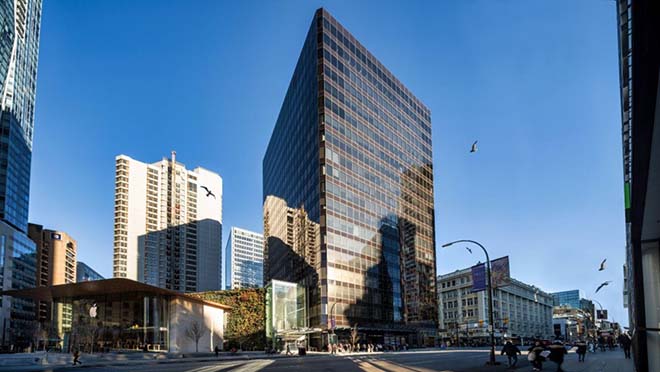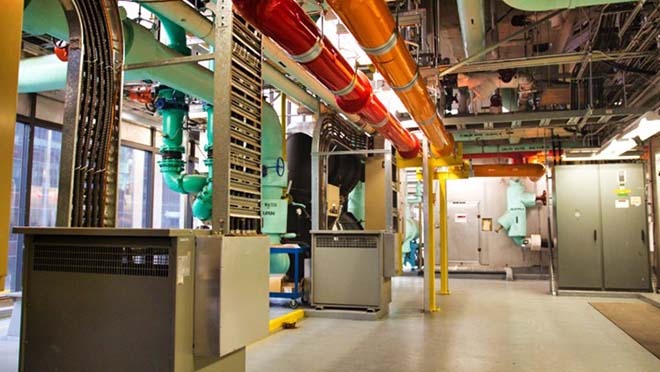 Thermal energy storage tanks under Cadillac Fairview Pacific Centre in Vancouver will store excess heat energy recovered from cooling processes. That heat will be redirected as needed to other parts of the Pacific Centre Complex, which includes three Cadillac Fairview office buildings. (Photo courtesy Cadillac-Fairview.com)
Thermal energy storage tanks under Cadillac Fairview Pacific Centre in Vancouver will store excess heat energy recovered from cooling processes. That heat will be redirected as needed to other parts of the Pacific Centre Complex, which includes three Cadillac Fairview office buildings. (Photo courtesy Cadillac-Fairview.com)
Thermal storage below the Pacific Centre Complex to share heat energy between multiple buildings
Part of a series on BC Hydro Clean Energy Champions: businesses, homes, and institutions – large and small – recognized for reducing their reliance on fossil fuels.
The network of pipes that carry steam from a district energy plant alongside BC Place Stadium to heat a variety of buildings across downtown Vancouver is a technological marvel launched way back in 1968. But while it solved the problem of individual buildings being heated by inefficient and polluting coal and fuel-oil, the steam plant's efficient boilers are still the product of burning natural gas.
Even though the source of that steam is going to change – Creative Energy will soon electrify steam production at the district energy plant – Cadillac Fairview wants to reduce its reliance on steam at the Pacific Centre Complex.
"A key component of our decarbonization strategy is to proactively reduce our consumption of steam," says Derek Hurley, General Manager of Office for Cadillac Fairview's Pacific Centre and RBC Place buildings. "Our priority is to make sure that our buildings today operate as efficiently as possible and that we leverage heat recovery technology to reduce our carbon output."
They're doing it by installing heat recovery chillers and parking a series of thermal energy storage tanks under the Pacific Centre Complex and using them to store excess heat energy recovered from cooling processes, which is required year-round in the complex. That recovered heat will be either redirected to other parts of the complex that require it or stored in the tanks until it's needed.
Completed in early 2025, the project is expected to reduce emissions by up to 3,000 tonnes of CO2 annually. It will also save on energy costs through the reduction of about 53,000 gigajoules annually by 2030.
"Instead of excess heat being run through cooling towers and released into the atmosphere, the heat recovery chillers capture that heat and redirect it to other areas of the complex where it's needed or store it in the thermal energy tanks," says Hurley. "We've specifically interconnected those thermal energy storage tanks between four buildings – 700 West Georgia, 701 West Georgia, 609 Granville, and the retail shopping centre. They're able to draw upon that waste heat in the thermal energy storage tanks and extract it as needed."
 Waste heat from the building’s operations are captured and channeled to other building systems using heat recovery chillers and piping, reducing the need for additional outside energy.
Waste heat from the building’s operations are captured and channeled to other building systems using heat recovery chillers and piping, reducing the need for additional outside energy.
BC Hydro low carbon electrification incentives help get it done
Cadillac Fairview (CF) has a significant footprint in downtown Vancouver – nearly four million square feet spread out over 10 office buildings plus CF Pacific Centre. The Pacific Centre Complex alone spans three city blocks with six office towers plus the shopping centre, and four other buildings are located along the waterfront, east of the Vancouver Convention Centre.
To reduce emissions in as many buildings as possible, the company completed a pair of fully funded BC Hydro low carbon electrification studies and received incentives towards project implementation. In addition to the heat recovery project at the Pacific Centre Complex, Cadillac Fairview will replace air-cooled chillers with air source heat pumps at its Waterfront Properties. They'll connect the heat pumps to a refurbished 400,000-gallon thermal energy storage tank, and replace several steam-to-hot water heat exchangers with electric domestic hot water heaters.
Although upgrades at each of Cadillac Fairview's office buildings are progressing at a different pace, all towers are now equipped with heat recovery systems. That has helped Cadillac Fairview's goal of compliance with the City of Vancouver's 2026 carbon intensity limits in addition to their own emission reduction targets.
"The overall support we've received from BC Hydro has been very helpful in moving projects forward, from commissioning studies to financially supporting the project," says Hurley. "We've been very fortunate to have a great team at BC Hydro to support our vision and projects."
Cadillac Fairview will not rest on these most recent upgrades. The company has committed to a net zero goal by 2050, with an interim target of 35% absolute emission reduction by 2030 from the 2017 baseline.